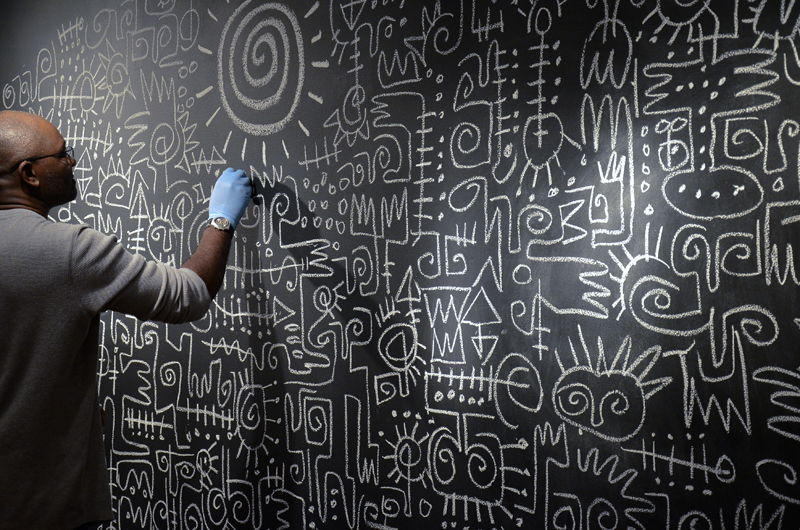
Visiting artist Victor Ekpuk will work in the Mayer Gallery of the Turchin Center for the Visual Arts during public hours April 3-4 as a performance piece that goes through the artistic process of what he calls “Drawing Memory.”
The performance is both a promotion of and creation for his upcoming exhibition of the same name that opens April 5.
Ekpuk, an established Nigerian artist currently working out of Washington, D.C., will also present “African Art Symposium: Symbol and Space” April 6 in the Turchin lecture hall, room 1102.
The Appalachian spoke with Ekpuk about his art, his personal history, and his upcoming exhibition.
The Appalachian: How would you describe your work?
Victor Ekpuk: “In a general sense, I would describe my work as abstraction.
Part of my visual vocabulary is consciously or unconsciously derived from traditions of ideographic writing systems in Africa, where ideas and forms are reduced to their essence through graphic symbols. In my compositions, the use of these arcane signs and my invented ‘pseudo-writings’ often evoke an interplay of art and writing, where legibility and illegibility are metaphors for contemporary expressions.”
TA: What is your artistic process like? What inspires you?
VE: “My process often starts with a pen or pencil in hand, and if an idea occurs to me, I may unconsciously draw on the nearest surface. These days, the drawing apps in my iPhone or iPad have become added tools for beginning the process for documenting the myriad form floating around in my head. Many things can trigger my inspiration, the human condition, forms in nature, a song, a poem and so on.”
TA: How did you get started as an artist?
VE: “My recollection of my artistic talents was from very early in my childhood when I could draw realistic representations of people and objects before I learned to write the alphabet in elementary school. Encouraged by my mother, at age of 8, I won first prize in a statewide art competition. All through high school, art was the one subject I was most interested in. My love for drawing was such that every school notebook and textbook became a sketchbook. Studying art in the university and opting to become a professional artist was an obvious choice.”
TA: What of your work is represented in “Drawing Memories”? Is there a common theme in this collection?
VE: “The drawing performance piece that will be executed from April 3-4 best represents ‘Drawing Memory.’ This piece is an example of work where the human condition is the main inspiration. Memory to me is a metaphysical space where our sense of self resides. My observation is that this sense of self is acquired through family, ethnic, racial relationships. Life circumstances can cause memories to change, shift, evolve or even transform. The act of ‘Drawing Memory,’ which will eventually be wiped off to make room for another experience, is perhaps pondering the notion of memory, the experiences that give us our sense of self or identity, as ephemeral conditions.”
TA: How is this similar or different to your work overall?
VE: “This piece continues the idea in other works where I ponder the human condition. The difference here is in its ephemerality.”
TA: Do you have any expectations about the opening or your time here in Boone?
VE: “I have never been to the Appalachian Mountains or North Carolina, I hope to have fun and good conversations with the people of Boone.”
Story: LOVEY COOPER, Senior A&E Reporter
Photo Courtesy: VICTOR EHIKHAMENOR

